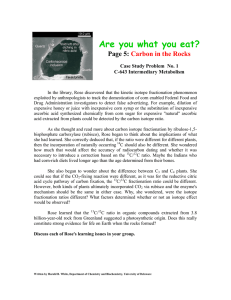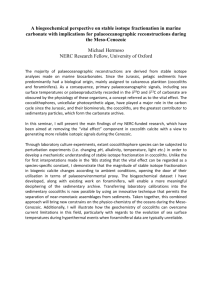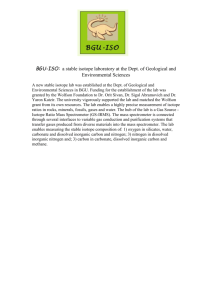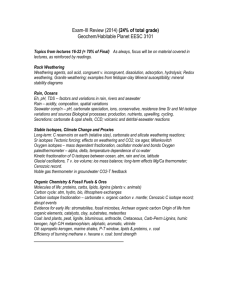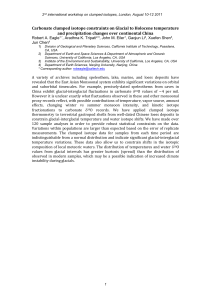Isotope Stratigraphy
advertisement
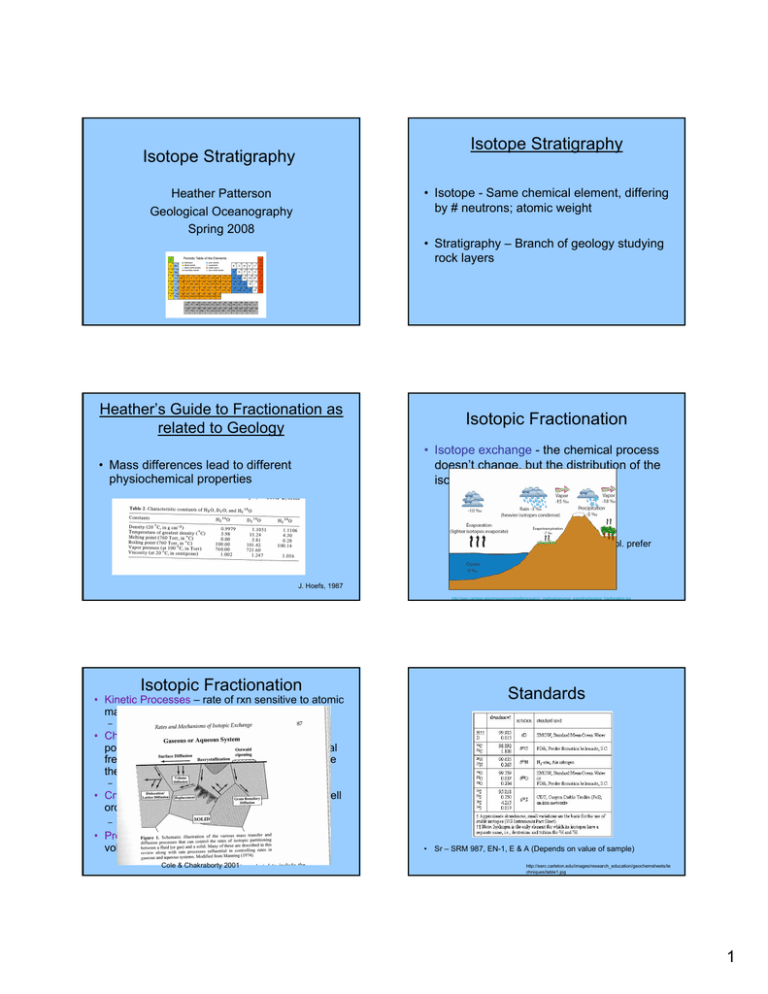
Isotope Stratigraphy Isotope Stratigraphy • Isotope - Same chemical element, differing by # neutrons; atomic weight Heather Patterson Geological Oceanography Spring 2008 • Stratigraphy – Branch of geology studying rock layers Heather’s Guide to Fractionation as related to Geology Isotopic Fractionation • Isotope exchange - the chemical process doesn’t change, but the distribution of the isotopes change • Mass differences lead to different physiochemical properties • Fraction factor α = RA/RB • Delta value – δA = (RA/RSt -1) * 103 (‰) – δB = (RB/RSt -1) * 103 (‰) • Evaporation/Condensation – lighter mol. prefer vapor phase J. Hoefs, 1987 http://serc.carleton.edu/images/microbelife/research_methods/environ_sampling/isotope_fractionation.jpg Isotopic Fractionation • Kinetic Processes – rate of rxn sensitive to atomic mass Standards – Diffusion • Chemical Composition - Ions w/high ionic potential, low atomic mass, have high vibrational frequencies - therefore preferentially incorporate the heavier isotope – 18O is bound in quartz, and magnetite is deficient • Crystal Structure - Heavier isotope packed in well ordered structure – Graphite and diamond, fractionation is 11.5‰ • Pressure – Can be important in rocks, change volatility Cole & Chakraborty 2001 • Sr – SRM 987, EN-1, E & A (Depends on value of sample) http://serc.carleton.edu/images/research_education/geochemsheets/te chniques/table1.jpg 1 Carbon Oxygen • Fractionation – Photosynthesis – concentration light (12C) in organic material – Chemical exchange – enrichment (13C) in bicarbonate – Not the same in all organic matter (lipids, carbohydrates, proteins) – Temperature in calcium carbonate – effects the precipitation point • Diffusion is different between wet and dry conditions • Water-Rock interactions – if rock greater, fluid modified, if water greater than rock modified J. Hoefs, 1987 Strontium J. Hoefs, 1987 Mass Spectrometry • Used as indicator of water-rock interaction, a tracer for groundwater movement and the origin of salinity • Depends on contributions of weathering from land and hydrothermal activity • Is geochemically substituted for Ca2+ http://en.wikipedia.org/wiki/Ma ss_spectrometry http://www.science.uottawa.ca/~eih/ch9/9stront.html McArthur, 1994 Purpose: To review uses and misuses of strontium isotope stratigraphy Background info. • Can date back the Cenozoic, but not easily further – Can’t find unaltered fossils/rocks • Variation of 87Sr/86Sr – related to loss from hydrothermal circulation – leaching from basalts – weathering from land • Sr residence time 106 (longer than mixing 103) – Sr well mixed – Flux from rivers (except 4 not enough to make a difference) 2 Samples used Scanning Electron microscope • Carbonate, chalk, barite • Belemnites, bivalves • Good ultrastructure morphology = sample integrity • Need to make sure unaltered – 87Sr/86Sr to within 20 * 10-6 of original value • not the best for aragonite epswww.unm.edu/.../virtualtou r/laboratories.htm A scanning electron microscope (SEM) image of the planktonic foraminifera Globogerinoides fistulosus. www.csiro.au/science/ps1qb.html X-ray Diffraction • Can detect to 0.5% of crystal contamination • But calcite & aragonite can recrystalize without altering their mineralogy • But since its rare for 2° aragonite, may be best method for aragonite Amino Acid Analysis www.phy.cmich. edu/people/petko v/x-ray.html • Organic matter probably more susceptible to alternation – Good preservation of OM = Good preservation of carbonate www.esrf.e u/.../2003/Im aging/Imagi ng08 Cathodeluminescene Chemical Analysis • Major elements – Al conc. warning of silicates – HCl acid leaches contaminates & changes Sr value – Contamination ok if doesn’t change Sr value • If carbonate luminesces that it is regarded as recrystalized Cathodoluminescent image showing non-luminescent calcite 3 • Trace elements – – – – Mg, Sr, Fe, Mn to track alterations Not useful for small degree alterations Aragonite – Mg >100 µg/g = contamination Biogenic carbonate – Fe/Mg >100 µg/g = contamination (anoxic/suboxic conditions) – Sr/Ca ratios lower than modern = recrystalization Sr Dating • Depends on – Slope of 87Sr/86Sr • Depends upon gradient – Accuracy of age model used • Internal consistency = original • Model alteration • Selective dissolution – minimize contamination • Need correct boundaries – Analytical quality of data – lab bias • Appropriate standard • Differs between labs = 61 * 10-6 • Appropriate understanding of Rb-decay Statistics • Linear • Polynomial • Non-parametric regression (LOWESS) Wierzbowski, 2002 Purpose: Provide 13C & 18O data from brachiopods & belemnites from the Oxfordian (161.2 ± 4.0 MA) and discuss Applications in Stratigraphy • • • • • • • • Date sediments Determine subsidence at atolls Define sea level change Aid in oil exploration Distinguish between marine & non-marine fish Dating phosphogenesis Defining inflexions ID disaster, K/T boundary Methods • Thin slabs of organisms – Polarizing microscope – Cathodoluminscence (no/slight luminescence) – SEM – preserved microstructure (Cross-polarizing microscope photographs of typical structures of volcanic rock (left) and plutonic rock (right) http://www.sand4students.net/en/images/text04_p5.jpg) www.plingfactory.de http://www.tonmo.com/science/public/belemnites.php 4 Results & Discussion • 2.5-3‰ difference in δ13C between belemnites & brachiopods – habitat? Vital effect?? • δ18O values similar • Uniform values around 0‰ •Max δ13C middle Oxfordian – related to sea level change Discussion Points • Do you “buy” the use of isotopes? • Are there any biases/misuses that you can think of? - “Vital effects” • How might you use them in your own research? • The paleotemperature equation for calcite developed by Epstein et al. (1953) and modified by O’Neil et al. (1969) is: – T (◦C) = 16.9–4.38(δ18Oca − δ18Ow) +0.01(δ18Oca − δ18Ow)2 • where δ18Oca is the oxygen isotope ratio for a calcite • sample and δ18Ow the oxygen isotope ratio for seawater. • The equation developed by Grossman and Ku (1986) for aragonite in mollusc shells is: T (◦C) = 21.8–4.69(δ18Oar − δ18Ow) – where δ18Oar is the oxygen isotope ratio for an aragonite – sample and δ18Ow the oxygen isotope ratio for seawater 5

